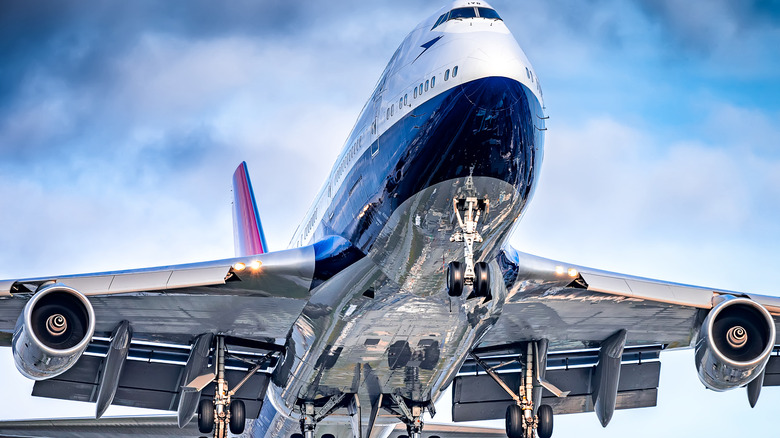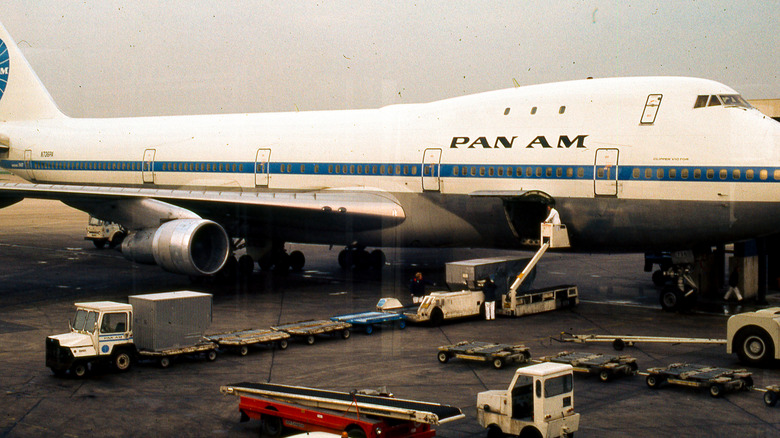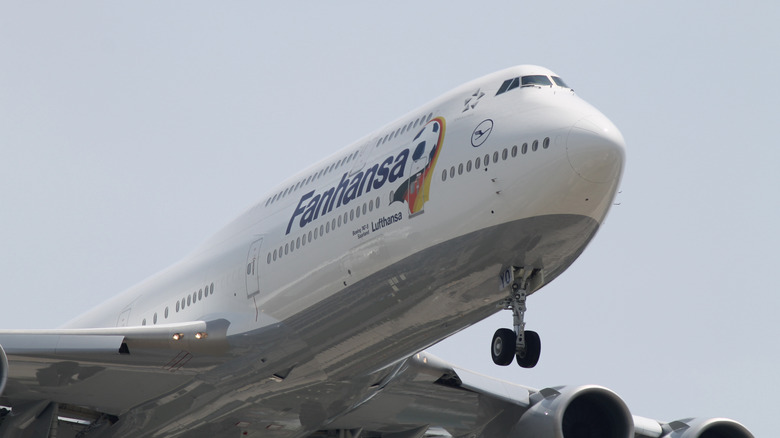How Much Fuel Does A Boeing 747 Need To Fly At Max Range?
At 01:52 EST on January 22, 1970 an aviation legend made its first paying passenger flight. The Boeing 747 Pan Am flight from JFK to London Heathrow was the first commercial flight to feature a plane that would rule the long-haul air routes for decades to come and become synonymous with the burgeoning jet age. However, it wasn't a smooth introduction to service, with issues occurring on both the outbound and return journeys. On the outbound journey, the original plane developed engine problems shortly before take-off and a replacement plane had to be organized. On the return journey passenger numbers had to be restricted due to a fault with the emergency slides. However, this was the low point of the career of a jet destined to become the most iconic commercial plane of all time and a craft still considered one of the best jets in the sky.
Over the coming years, the jet underwent continual development. Even though the spirit of the original design remained, this development is clearly visible when comparing the last version to emerge from Boeing's production line-the 747-800-with the jet that began the story. A large part of the development process was to improve fuel efficiency. The later models of the jet were able to fly far further on a "full tank of gas", a point much appreciated by airlines. Of course, this begs the question; Just how much fuel does a Boeing 747 need to fly its maximum distance? By looking at this across the different generations, we not only discover just how far this design evolved but also how much more fuel-efficient commercial aviation became generally over the same period.
Fuel consumption and max range explained
Before we begin to look at the numbers, it's important to understand what is meant by maximum range and the variables that can affect it. This allows us to lay the ground rules needed to draw a fair comparison. First, let's look at what we mean by max range. Although this is obviously the furthest distance a Boeing 747 can fly on full tanks, we need to set some baselines that we can apply to the calculation. Factors like weather, altitude, cruising speed, and passenger/cargo load all need to be considered. These variables will all affect the airplane's performance and how we quantify what its maximum range is.
Of course, we could simplify it and just state that the amount of fuel the jet needs to fly its full range is simply knowing how much fuel a Boeing 747 can hold. But that would be too easy. To get a more complete picture, we can dig a little further into the figures and look at how things like engine efficiency, aerodynamic improvements, and fuel capacity all affected what was achievable on full tanks. To see just how far things progressed, we will look at the first and final passenger variants of the jet, namely the original 747 version that made the maiden flight and the 747-800 variant. We'll also simplify by assuming the planes flew in perfect conditions at the optimum altitude, at the normal cruising speed, and were flying free of inconveniences like passengers or cargo.
Boeing 747 models and their maximum range
Let's begin where it all started with the Boeing 747-100 variant that was the first to make a commercial flight. This plane was powered by four Pratt & Whitney JT9D-3AW engines, each producing up to 19,730 kg of thrust. These powered the jet to a maximum speed of 616 mph with an impressive cruising speed of 595 mph. However, in terms of this article, the more important figures are a maximum fuel capacity of 48,066 US gallons (181,950 liters), giving it a maximum range of 5,620 miles (9045 km). From this, we can perform a simple calculation (fuel efficiency = max range/fuel capacity). Plugging the figures in, we can extrapolate that the fuel efficiency of this model is 0.117 mpg or 0.050 kpg.
Next up, let's look at the 747-800 passenger variant. This was powered by four GE GEnx-2B engines, each of which produced a thrust of 66,500 lbs of thrust (30164 kgs). These gave the 747-800 a top speed of 614 mph (988 km/h), a cruising speed of 572 mph (920 km/h), and a potential range of 8,482 miles (13,650 km). Now, we need the fuel capacity — the standard capacity of this variant is 64,300 US gallons (243,400 liters). Finally, we can plug these figures into the calculation, and we see that the fuel efficiency of this version is 0.132 mpg or 0.056 kpg. Those numbers are surprisingly close to the 747-100, which underlines just why this remains one of the best jets Boeing ever made. But it's still a substantial enough saving when considered from the point of view of an aircraft traveling thousands of miles each day.


